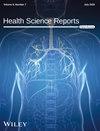Prevalence and Associated Factors of Intestinal Parasitic Infections and Undernutrition Among Elementary School Children in Zenzelima Town, Northwest Ethiopia: A School-Based Cross-Sectional Study
Abstract
Background and Aims
Intestinal parasites and malnutrition are major public health challenges in Ethiopia, highlighting the need for local epidemiological data to inform effective prevention and intervention strategies. This study aimed to assess the prevalence of intestinal parasitic infection, undernutrition, and their associated risk factors among elementary school-aged children in Zenzelima town, Northwest Ethiopia.
Methods
A school-based cross-sectional study was conducted from January to May 2022. Systematic random sampling was used to select study participants. Sociodemographic and risk factor data were collected using a structured questionnaire. Height and weight measurements were taken using a meter and calibrated balance. Fresh fecal samples were collected and processed using wet mount and formol-ether concentration techniques.
Results
Of 405 study subjects, 201 (49.6%) were infected with one or more intestinal parasites. The predominant parasite was hookworm (22.2%), followed by Giardia lamblia (19.8%) and Entamoeba histolytica (13.6%). Habits of eating raw vegetables/fruits (adjusted odds ratio [AOR] = 2.03; 95% confidence interval [CI]: 1.330–3.11), having irregular use of closed shoes (AOR = 1.86; 95% CI: 1.09–3.47), and exhibiting the habit of open-field defecation (AOR = 3.07; 95% CI: 2.00–4.71) were identified as independent predictors of intestinal parasitic infections. Alternatively, the overall prevalence of undernutrition among children was 58.3%, consisting of 49.1% for wasting, 25.9% for stunting, and 14.6% for underweight. Meal frequency at most three times a day (AOR = 3.24; 95% CI: 1.98–5.32) and infected with intestinal parasites (AOR = 1.84; 95% CI: 1.19–2.83) were strongly associated with undernutrition.
Conclusion
The prevalence of intestinal parasitic infections and undernutrition was high among school children in Zenzelima, Ethiopia. In this study, eating raw vegetables/unwashed fruits, irregular use of closed shoes, and open-field defecation were statistically significant risk factors for intestinal parasitic infections. Moreover, low meal frequency and intestinal parasitic infections were significantly associated with undernutrition. These results highlight the need to strengthen integrated strategies to reduce both intestinal parasitic infections and undernutrition.

 求助内容:
求助内容: 应助结果提醒方式:
应助结果提醒方式:


